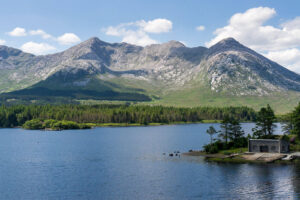Visitors to our shore are often bemused that the Irish language (or Gaeilge) is not widely spoken despite appearing on signs, plaques and all manner of places. However, the language holds a unique and profound significance in Ireland. As one of the oldest languages in Europe, it is not only a critical part of Ireland’s cultural heritage but also a living symbol of the nation’s identity and resilience.
Historical Significance
Gaeilge is a Celtic language with roots stretching back over two thousand years, predating the arrival of English on the island. For centuries, it was the dominant language spoken by the majority of the population. However, the arrival of English-speaking settlers, followed by British colonisation, led to a significant decline in its use. By the 19th century, famine, emigration, and official policies favouring English meant Gaeilge slowly became a minority language.
Despite this, Irish has remained a key part of Ireland’s cultural identity. The language was instrumental in the nationalist movement, with leaders like Patrick Pearse and Douglas Hyde advocating for its revival as a cornerstone of Irish independence. This led to the establishment of Gaeilge as an official language of the state when Ireland gained independence in 1922.
Where Irish is Spoken Today
Today, Gaeilge is spoken in several regions across Ireland, most notably in the Gaeltacht areas – designated regions where Irish is the predominant language. These regions include parts of counties Donegal, Galway, Kerry, Mayo, and smaller pockets in counties Cork, Meath, and Waterford. The Gaeltacht areas are vital for the preservation of the language, offering a rare glimpse into Ireland’s linguistic past and a way of life steeped in tradition.
Note: To this day, the Aran Islands off the coast of Galway offer a window into traditional Irish living. The islands, of which there are three – Inis Mór, Inis Meáin and Inis Oírr – is home to residents who still speak the native tongue. Check out our Inis Mór and Aran Islands tour pages for more information.
Outside the Gaeltacht, Irish is also spoken and studied widely across Ireland. It is a compulsory subject in schools, ensuring that all Irish children have a basic understanding of the language. While fluency levels vary, this educational policy has played a crucial role in maintaining the language as a living aspect of Irish culture.
Additionally, the urban revival of Gaeilge, particularly in cities like Dublin, has seen an increase in the use of the language in daily life, arts, and media. Irish-language media, such as TG4, the national Irish-language television station, and Raidió na Gaeltachta, contribute significantly to the language’s modern relevance.
Is the Language Dead?
Far from it!
An estimated 1.7 million people (around 40% of the population) within Ireland claim some ability to speak Gaeilge. As of 2022, 72,000 people in Ireland speak Irish regularly (daily), with Connemara in Galway one of the largest strongholds of the Irish language.
Why Gaeilge Matters
The importance of Gaeilge extends beyond its historical and cultural value. It serves as a symbol of Ireland’s identity, embodying the nation’s resilience and determination to preserve its unique cultural heritage. Language is a vehicle for expressing worldviews, values, and traditions that are intrinsically linked to a people’s history. In this light, Gaeilge offers a connection to Ireland’s past, a continuity with traditions that might otherwise be lost.
The language has gained new significance in recent years as part of a broader global movement to protect and revive indigenous and minority languages.
–
The Irish language is a vital thread in the fabric of Irish identity. Despite the challenges it has faced, the language remains a living testament to the resilience and cultural pride of the Irish people. Whether in the Gaeltacht regions, schools, or town centres, Gaeilge continues to be a cherished part of Ireland’s heritage, symbolising both the country’s ancient past and its modern, vibrant cultural identity.
The ongoing efforts to preserve and promote Gaeilge are crucial not only for Ireland but for the global community’s appreciation of linguistic and cultural diversity.
Explore more of Ireland’s cultural heritage and remarkable landscapes by visiting our tours page.


